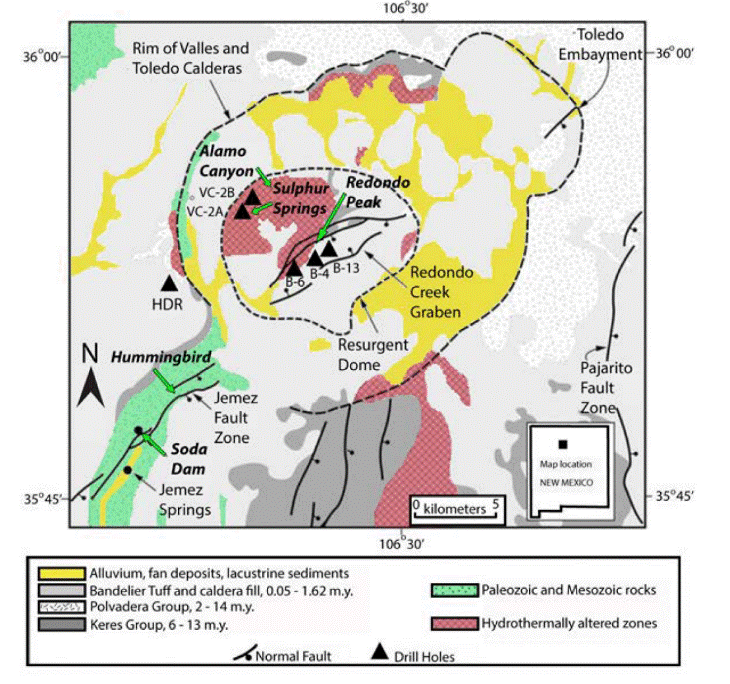Valles Caldera is located in northcentral New Mexico, approximately 56 km northwest of the state’s capital, Santa Fe (Fig. 1). It is part of the Jemez Mountains volcanic field (JMVF) and is situated along the southwest to northeast trending Jemez lineament. The JMVF is also bordered by the north-south trending Rio Grande rift to the east. VC is located at the intersection of these two structural features. Volcanism in the JMVF began at approximately 16.5 Ma, and basaltic and rhyolitic magmas erupted throughout the Tertiary and into the Quaternary period (Self et al., 1986). The commonly observed Bandelier Tuff was deposited about 1.4 Ma after eruption from a shallow magma body that resided underneath the lineament-rift intersection (Self et al., 1986).

Figure 1: Location of study sites and geologic map within Valles caldera (figure modified from Goff and Janik, 2002). Sites with preliminary measurements indicated by green outlined arrows.
Briefly, the formation of VC began with the eruption that formed the Toledo caldera 1.45 Ma, which is estimated to have had a volume of 600 km3 (Heiken et al., 1990). Following that eruption, VC was created at 1.12 Ma by a 500 km3 eruption. The force of the caldera-forming eruption caused the floor of the region to collapse, and in doing so several ring fractures formed around the perimeter of the caldera (Goff and Grigsby, 1982). Subsequent eruptions up until ~70 ka were followed by erosion, exposing the Upper Bandelier Tuff and rhyolites (Goff and Grigsby, 1982; Self et al., 1986; Goff, 2009). After the collapse of the caldera floor, resurgent uplift created several rhyolitic domes near the center of VC. The most recent eruption, the East Fork Member, occurred at ~70 ka, and was preceded by subsurface magmatic activity up to >350 ka, as determined through U/Th dating of zircon grains (Zimmerer et al., 2016). Associated lavas occur only within the caldera (Wolff et al., 2011).
Valles Caldera was privately owned until 2000, when the federal government formed a trust, purchased it, and established the Valles Caldera National Preserve (Goff, 2009). This has opened up exciting new opportunities to study this type example of a Quaternary caldera and active volcanic system. VC has a well-developed hydrothermal system consisting of a saline aqueous fluid and a CO2-rich gas cap (Goff and Gardner, 1994). Springs and fumaroles in and near the caldera release CO2-rich gas. Potential subsurface CO2 sources include the magma chamber at ~5 km depth and degassing of carbonate rocks due to de-carbonation reactions. The δ13C of these CO2 sources overlap, making it difficult to identify the source using carbon isotopes alone (Goff and Janik, 2002). Sites we visited in summer 2017 included Sulfur Springs, Soda Dam, Alamos Canyon, and Redondo Peak (Fig. 1). Sulfur Springs is an acid-sulfate hot spring system within VC associated with intersecting faults and numerous springs and fumaroles (Goff et al., 1985). Soda Dam is a low temperature travertine deposit just outside VC that formed by spring discharges (Goff and Shevenell, 1987). CO2-rich bubbling springs discharge within Alamos Canyon, while Redondo Peak is a structural uplift with known hydrothermal activity (Goff, 2009).
References
Goff F. (2009) Valles Caldera: A Geological History. 1st ed., University of New Mexico Press, Albuquerque.
Goff F. and Gardner J. N. (1994) Evolution of a mineralized geothermal system, Valles Caldera, New Mexico. Econ. Geol. 89, 1803–1832.
Goff F., Gardner J., Vindale R. and Charles R. (1985) Geochemistry and Isotopes of Fluids From Sulphur Springs, Valles Caldera, New Mexico. J. Volcanol. Geotherm. Resarch 23, 273–297.
Goff F. and Grigsby C. O. C. (1982) Valles Caldera Geothermal Systems, New Mexico, USA. J. Hydrol. 56, 119–136. Available at: http://www.sciencedirect.com/science/article/pii/0022169482900610.
Goff F. and Janik C. J. (2002) Gas geochemistry of the Valles caldera region, New Mexico and comparisons with gases at Yellowstone, Long Valley and other geothermal systems. J. Volcanol. Geotherm. Res. 116, 299–323.
Goff F. and Shevenell L. (1987) Travertine deposits of Soda Dam, New Mexico, and their implications for the age and evolution of the Valles caldera hydrothermal system. Geol. Soc. Am. Bull. 99, 292–302.
Heiken G., Goff F., Gardner J. N., Baldridge W. S., Hulen J. B., Nielson D. L. and Vaniman D. (1990) The Valles/Toledo Caldera Complex, Jemez Volcanic Field, New Mexico. Annu. Rev. Earth Planet. Sci. 18, 27–53.
Self S., Goff F., Gardner J. N., Wright J. V and Kite W. M. (1986) Explosive rhyolitic volcanism in the Jemez Mountains: vent locations, caldera development and relation to regional structure. J. Geophys. Res 91, 1779–1798.
Wolff J. A., Brunstad K. A. and Gardner J. N. (2011) Reconstruction of the most recent volcanic eruptions from the Valles caldera, New Mexico. J. Volcanol. Geotherm. Res. 199, 53–68. Available at: http://www.sciencedirect.com/science/article/pii/S0377027310003185.
Zimmerer M. J., Lafferty J. and Coble M. A. (2016) The eruptive and magmatic history of the youngest pulse of volcanism at the Valles caldera: Implications for successfully dating late Quaternary eruptions. J. Volcanol. Geotherm. Res. 310, 50–57. Available at: http://www.sciencedirect.com/science/article/pii/S0377027315004035.
